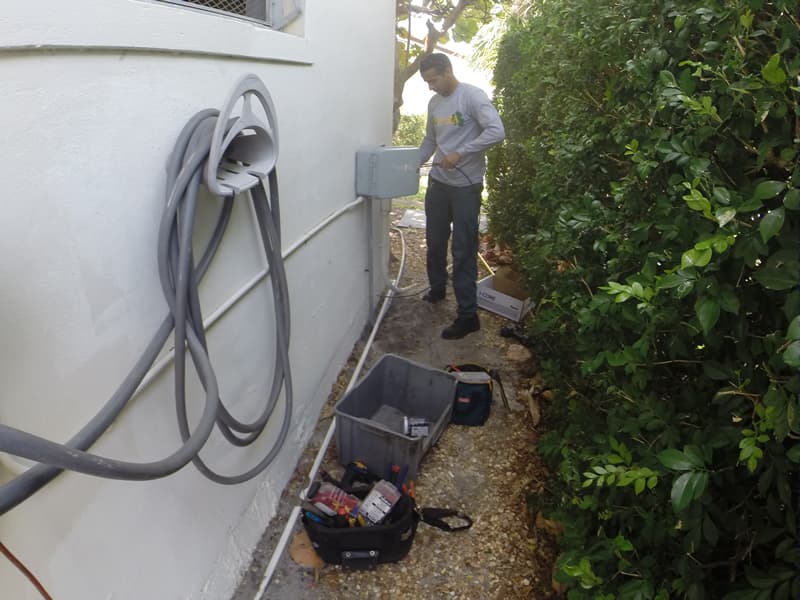Reliable Water

The Florida peninsula is one of the strangest chunks of acreage on the planet. Despite the pronounced lack of terrain, the climate at the north end of the peninsula will depart noticeably from the weather down south at any time of year, but will be especially different during the cooler months. On the same morning West Palm Beach wakes up to wind and 72 F temperatures, the residents in Stuart forty miles north find the mercury at 58 F, while one hundred fifty miles further north, Daytona Beach sits in a dead calm coated with frost. Coconut palms are extremely tropical, yet they thrive two hundred miles north of the Tropic of Cancer in Palm Beach and another eighty miles up the coast. Pushing more water than any river on Earth, including the Amazon River, the warm water Gulf Stream current emerges from the Gulf of Mexico, flows around Florida to within two miles of Palm Beach, and angles seven hundred miles northeast to warm the coconut covered island of Bermuda into the northernmost tropical paradise in the world.
Soils in Palm Beach, Martin, and Broward Counties are variants of beach sand that retain moisture about as well as fishing net. Seasonal rainfall is barely predictable as months of heavy rain are suddenly followed by months of no rain at all. This feast or famine seasonal rainfall is quickly and conspicuously measured by water levels in local lakes and canals as the effects of evaporation and porous retention are graphically indicated. Most areas of the peninsula will rapidly become as dry as a desert when the water stops, causing both edible and aesthetic crops to wither. Taken together, Florida's geographic characteristics make the acquirement and retention of life giving water a tricky proposition. In Palm Beach County and beyond, services provided to sustain healthy landscape aesthetics represent a billion dollar industry that employs tens of thousands of people.
The single most crucial component of this industry is Reliable and effective delivery of water to this massive investment. Landscape service providers can sharpen their blades, use careful pruning and mowing techniques, apply fertilizers and pesticides when necessary, and deliver timely execution of services in an effort to keep the landscape healthy and beautiful, but these services will not produce optimal results unless water arrives where and when it's expected.
As a form of plumbing, irrigation systems are much more forgiving than are indoor plumbing systems. For one thing, collateral damage from a leaking or broken sprinkler flow can usually be repaired with a shovel. Damage caused by indoor plumbing leaks is much more costly and can result in anything from soggy carpets to major structural failure. Sprinkler systems are plastic. Plumbing is metal. Sprinklers are supposed to spread water. Plumbing keeps water from running away. While it is much more difficult to transition from a sprinkler technician to a plumber than the other way around, irrigation workers nonetheless require months of training before they can be trusted with even the most basic repairs.
Unlike plumbing service which is reactive, irrigation service is proactive. This means that plumbing is serviced in response to a problem whereas sprinklers are checked and serviced to prevent problems. This is because irrigation exists to keep valuable landscaping alive and healthy. Since sprinkler systems are outdoors, they are sometimes adversely affected by extra structural variables that are not a factor inside buildings. Such variables include root compression, vehicular compression, soil intrusion, intrusion by algae, snails, and other life forms, blind digging, ultraviolet light (solar) damage, erosion, and operational incompetence. Roots and vehicles are going to crush components. Dirt and animals are going to get into components. UV rays are going to distort pop up pistons on sprinklers.
Either sudden or gradual erosion is going to expose or collapse components. However, of all these events, operational incompetence is not necessarily going to cause any damage because it is the one variable that can actually be controlled with proper technical training and common sense preparation. When a sprinkler technician begins a service inspection, his primary concern must be the health of the turf and foliage. During periods of little or no precipitation, conspicuous wilting will inevitably guide the technician to the source of the problem in the irrigation coverage. Unless the trouble is widespread, the technician must begin by looking for low tech resolution to the lack of coverage.
Is a sprinkler covered with grass? Has a strong wind been pushing the water off target? Has shrubbery grown over a nozzle? Did a somebody leave a garden hose rolled up on top of a sprinkler? Most minor wilting is the result of low tech, easily rectified problems like these. An individual who is highly skilled mechanically, but lacks the common sense to start low tech will too often diagnose poorly. Although willing and able to make necessary repairs or modifications, that person won't always know what repairs or modifications have to be made and will never become a good technician.
Nineteenth Century mountain men who trapped and dined upon mountain lions coined the expression "There's more than one way to skin a cat." As with everything else in life, a diagnosed sprinkler system problem can be problematic, requiring the technician to choose the best, most practical course of action. If it is acquired at all, the ability to diagnose problems and then decide upon and properly execute the optimal solution can only be acquired with long term experience and continuous training.




